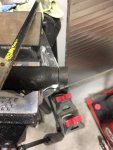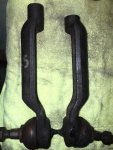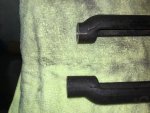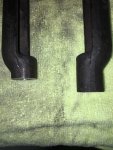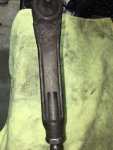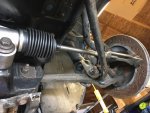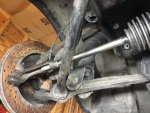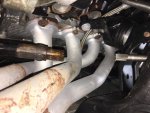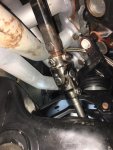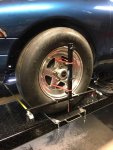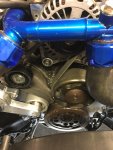Yes, the QuickTrick alignment kit has 2 fixtures, one for each side. Included are two tape measures that attach to slots in the cross bars to measure in front of and behind the wheels to measure the total toe. (The kit I have only has one digital level to check caster/camber but they have a kit with two digital levels. They even have their own turntables but I used a different pair.)
You wouldn't necessarily need to 'string the car' if you were just checking the alignment. But since I had replaced the entire rack and everything had been disconnected, the entire steering system was out of adjustment. If you were to use the tapes only you could in theory adjust the toe but it could be to the left or right as a parallelogram - with both the front and rear measuring the same but not square with the car chassis.
So what I did was center the steering wheel and secured it in place with the aid of the seat belt and power seat. I put the lap/shoulder belt through the steering wheel and clicked into place with the seat adjusted forward. I then adjusted the seat rearward tightening up on the belt until the steering wheel was secured from moving. (Oddly enough, the steering wheel "lock" is slightly "off center".)
With the car on the lift and the lift at bench height, I disconnected the shift cable from the transmission and rolled the car forward to the front wheel stops on the lift. I then positioned the turntables behind the front wheels and then rolled the car back so the front wheels were centered on the turntables. I then chocked the rear wheels to prevent any unintended movement. (Disclaimer... the turntables I used are 'full motion' - meaning they can and will slide any direction -not just "turn". Caution must be used to not put any lateral force on the front of the car as you could easily slide the car right off the lift!

)
Of course the car is not necessarily square and/or centered on the lift, so I rigged up two string-lines, one on each side at hub height using some clamps and short pieces of aluminum angle. I clamped a section of angle on each corner of the four post lift for a fixture to tie the string to. I adjusted each string-line until it was parallel to the car by measuring from the string to the center of the hub on the front and back wheels. (I tried to use a laser in place of the string but it was almost impossible to position the laser exactly where it needed to be. Trying to adjust the laser 1/16" at a distance of 20 feet or so is a lot tougher than it appears!)
Now with two string-lines, parallel to each side of the car, it was simply a matter of measuring and calculating to determine if they were parallel to each other. I measured from the string to each corner post of the lift and then measured from post to post on the front and rear. Believe it or not, my first attempt had the string lines within 3/16" of parallel for the length of the lift. It only took very minor adjustments to get them pretty much spot on, at least within the thickness of the mason twine I was working with.
So now the string-lines are set and the alignment fixtures are on the front wheels. According to the alignment fixture I had about 1" of total toe in. I then measured from the string to the front and back of each front wheel lip to determine the individual toe for each wheel. The passenger side was worst so I started there, adjusting the tie rod to zero toe measuring off the string line. Then I adjusted the drivers side. Once both sides were adjusted according to the string-lines, the tapes on the alignment fixture amazingly indicated the same! Now it was simply a matter of adjusting each side equally ever so slightly so there was just about 1/16" total toe in.
I can hear the naysayers already... no way they would go through all this when you could simply take the car to an alignment shop and their "machine" is much more accurate. If you've ever actually watched an alignment being done, you know it is not rocket science and it is almost never perfectly on target, it is simply within the tolerances allowed.
